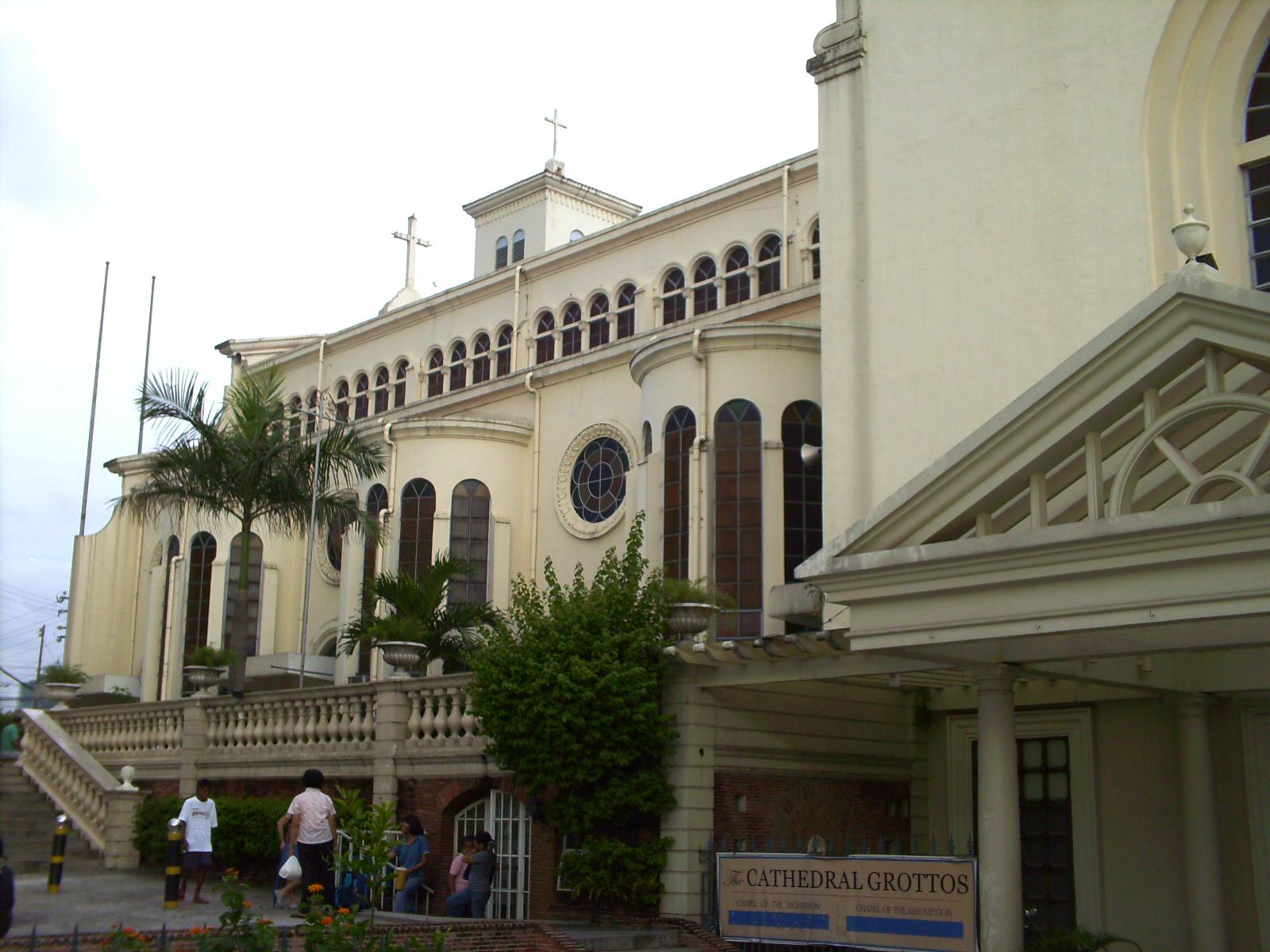
Cubao Cathedral (side view)
Cubao Cathedral, formally known as the Immaculate Conception Cathedral, is a Roman Catholic church located in Quezon City, Metro Manila, the Philippines. It is the cathedral of the Roman Catholic Bishop of Cubao. It was built in 1950 by the Society of the Divine Word, belonging to them until 1990 when the Archdiocese of Manila took over its administration. In 2003, it became the cathedral when the Diocese of Cubao was erected. The present rector of the cathedral is Rev. Fr. Ariston L. Sison, Jr., SCSL.
History
Since 1935, the SVD priests of Christ the King Mission Seminary attended to the pastoral and spiritual needs of a limited farming community around Manga Road in Cubao by first celebrating mass in a small chapel near the present Cubao Rotonda. Fr. Henry Demond, SVD, then celebrated mass at the residence of a certain Carbonell family, before to a quonset mess hall on what are now Spence and Brooklyn streets. The building was abandoned by the combined US-Philippine Commonwealth Armed Forces. As with other agrarian communities, farmers tilling the surrounding rice paddies invoked San Isidro Labradór, so the chapel built there was dedicated to him and belonged to the Sacred Heart Parish in Kamuníng. While teaching as a theology professor at Christ the King Mission Seminary (and later as Prefect of Scholastics), Fr. Ambrosio Manaligod consistently lent a helping hand to the pastoral work of the parish especially in the direction of lay organizations.
In 1949, the chapel was re-dedicated to the Immaculate Conception. On 15 July 1950, the community chapel was elevated into a parish, the first curé were the Argentine Fr. Juan Simon (1950–1954); he was succeeded by the German Frs. Alois Vogel (1954-1056) and Benito Rixner (1956–1958). For years the parish remained under the administration of the Society of the Divine Word, which was easy due to the proximity of the church to the main residence of the SVD missionaries at Christ the King Mission Seminary.
In 1989, SVD superiors offered the parish of the Archdiocese of Manila in keeping with the missionary spirit marked out in their constitutions. Official handover took place on Easter Sunday, 1990 with Msgr. Reynaldo Celso as the First Diocesan parish priest. Due to the population increase of Catholics in Metro Manila, the Archdiocese was gradually partitioned, creating the new diocese of Cubao on 28 August 2003. The parish was selected to be the seat of the new diocese and its bishop, and extensive renovations were carried out soon after.
Ecclesiastical territory
The Immaculate Conception Cathedral once belonged to the Archdiocese of Manila, but is now the seat of the Roman Catholic Diocese of Cubao. It icurrently remains a parish in its own right as a part of the Vicariate of the Holy Family.
Parochial bounds
The parish itself is bounded to the north by a creek running Eulogio Rodriguez Sr. and Ermín García Avenues; to the east by EDSA; to the south by Col. Bonny Serrano Avenue (Santolan Road); and to the southwest by a small portion of Ermitaño Creek, parts of Horseshoe Village, N. Domingo Street and Balete Drive.
Surrounding parishes are Sacred Heart to the north; Nativity of Our Lord and Our Lady of Perpetual Help to the east; and Our Lady of Mt. Carmel to the west. To the south is San Juan City, which is under the jurisdiction of the Archdiocese of Manila.
Where to stay
Here is the list of some of the accommodations that can be found around the city of Quezon, offering good services and comfortable rooms for all visitors.
- Imperial Palace Suites - Timog Avenue Corner Tomas Morato Avenue, 1103 Quezon City
- Torre Venezia Hotel - 170 Timog Avenue cor Scout Santiago St.,, 1100 Quezon City
- Dangay Suites - 99-A Dangay Street, 1105 Quezon City
- Eurotel Araneta Center, Cubao - General Araneta Corner General Roxas Streets, 1109 Quezon City
- The Sulo Riviera Hotel - Matalino Road, Diliman, Quezon City
- Sir William's Hotel - 39 Timog Avenue, 1103 Quezon City
- Lemon Tree Inn - 18 Scout Magbanua Street near corner of Quezon Avenue, Barangay Paligsahan,, 1103 Quezon City
- Robbinsdale Residences - # 14 Araneta Ave. corner Palanza St., 1113 Quezon City
- Mezza Residences Condote - Aurora Boulevard Corner Araneta Avenue, Guirayan Street, Barangay Dona Imelda, 1000 Quezon City
- La Breza Hotel - Mother Ignacia St., 7876 Quezon City
- Crowne Plaza Galleria Manila - Ortigas Avenue corner ADB Avenue, 1100 Quezon City
- Eastwood Richmonde Hotel - 17 Orchard Road, Eastwood City, Bagumbayan, 1110 Quezon City
- Stone House Bed and Breakfast Quezon City - 1315 E. Rodriguez Avenue, 1100 Quezon City
- Fersal Hotel - Annapolis - 49 Annapolis Street, Cubao, 1100 Quezon City
- The Oracle Hotel - 317 Katipunan Avenue, 1600 Quezon City
Getting around the city
Public transportation within the city, like in most of the urban areas in the Philippines, is facilitated mostly using inexpensive jeepneys and buses. Tricycles give access to more secluded areas, while taxi cabs are available to navigate any course.
This City has 3 Circumferential Roads. The following are:
- C-3: Sgt. Emilio Rivera Avenue and Araneta Avenue
- C-4: Epifanio de los Santos Avenue or EDSA
- C-5: Mindanao Avenue, Tandang Sora Avenue, Congressional Avenue Extension, Katipunan Avenue and E. Rodriguez Avenue
Railway
Currently, two elevated light rail systems and one heavy rail system run through Quezon City: LRT 1 – at EDSA (C-4) connecting North Avenue and Baclaran (Manila) LRT 2 – at Aurora Boulevard (R-6) connecting Santolan (Pasig City) and C.M.Recto Avenue (Manila), and MRT 3 – at EDSA (C-4) from Taft Avenue (R-2 in Pasay City) to North Avenue.
An elevated rail transit system (MRT-4) that was supposed to follow the general alignment of Quezon and Commonwealth Avenues (R-7) was shelved. In its place, a 22 kilometer rail system will be built. The MRT-7 project will commence at North Avenue, connecting the MRT-3 at its northern terminus. It will then go through Commonwealth Avenue, then through Regalado, Quirino Highway, ending in San Jose del Monte, Bulacan. The system has a proposed spur line to connect itself to MRT-2 in Katipunan, passing through the University of the Philippines Diliman and Katipunan Avenue.
The following elevated railway stations in the city (Only 13 Stations):
- MRT-3 (with 5 Stations):
- North Avenue- (Connected to LRT-1 Yellow Line)
- Quezon Avenue
- Kamuning
- Araneta Center-Cubao- (Connected to LRT-2 Purple Line)
- Santolan
- LRT-2 (with 5 Stations):
- Gilmore
- Betty Go-Belmonte
- Araneta Center-Cubao- (Connected to MRT-3 Blue Line)
- Anonas
- Katipunan
- LRT-1 (with 3 Stations)
- Balintawak
- Roosevelt
- North Avenue- (Connected to MRT-3 Blue Line)










